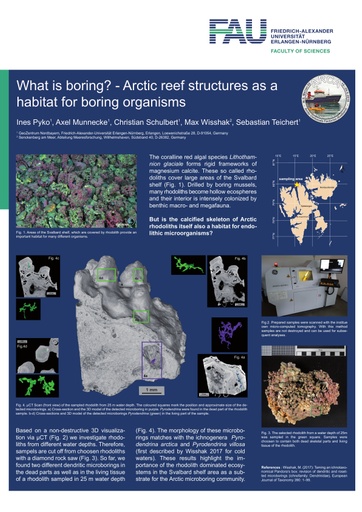pdf What is boring? - Arctic reef structures as a habitat for boring organisms Popular
1901 downloads

Ines Pyko
GeoZentrum Nordbayern, Friedrich-Alexander-Universität Erlangen-Nürnberg
Munnecke, Axel,GeoZentrum Nordbayern, Friedrich-Alexander-Universität Erlangen-Nürnberg, Erlangen, Germany; Wisshak, Max, Senckenberg am Meer Abteilung Meeresforschung, Wilhelmshaven, Germany; Teichert, Sebastian, GeoZentrum Nordbayern, Friedrich-Alexander-Universität Erlangen-Nürnberg, Erlangen, Germany
 The coralline red algal species Lithothamnion glaciale forms rigid frameworks of magnesium calcite. These so called rhodoliths cover large areas of the Svalbard shelf. Thereby, the calcified structures act as ecosystem engineers, comparable to corals in tropical regions, providing habitat for a large variety of organisms. Drilled by boring mussels, many rhodoliths become hollow ecospheres and their interior is intensely colonized by benthic macro- and megafauna. Based on a non-destructive 3-D visualization analysis via micro-computed tomography (µCT), we investigated whether the calcified skeleton itself provides a habitat for certain microorganisms also. Here, we present a first overview of boring microorganisms in Svalbard’s rhodoliths.
The coralline red algal species Lithothamnion glaciale forms rigid frameworks of magnesium calcite. These so called rhodoliths cover large areas of the Svalbard shelf. Thereby, the calcified structures act as ecosystem engineers, comparable to corals in tropical regions, providing habitat for a large variety of organisms. Drilled by boring mussels, many rhodoliths become hollow ecospheres and their interior is intensely colonized by benthic macro- and megafauna. Based on a non-destructive 3-D visualization analysis via micro-computed tomography (µCT), we investigated whether the calcified skeleton itself provides a habitat for certain microorganisms also. Here, we present a first overview of boring microorganisms in Svalbard’s rhodoliths.
This study is a contribution to enhance our knowledge about the complicated interrelationships in this large-scale ecosystem. Therefore, it is a step forward in order to estimate the impact of the rhodoliths on Svalbard’s shelf biodiversity and provides a background for their inclusion in future policy recommendations and strategic plans for biodiversity.

